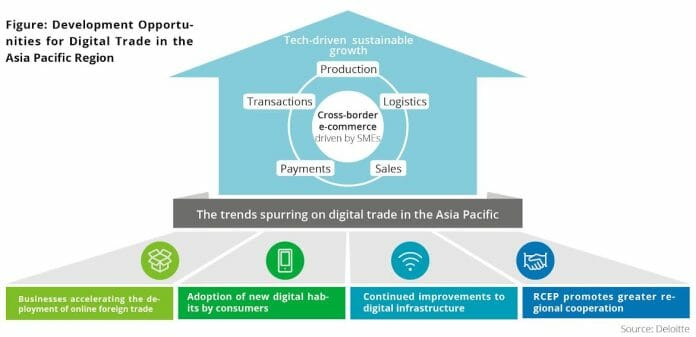Based on a survey conducted with businesses engaging in cross-border trade in the region, a Deloitte report <Technology-empowered Digital Trade in Asia Pacific> says digital trade is set to further accelerate on the back of dynamic cross-border e-commerce activities, rapid shifts towards a digital lifestyle by consumers, ongoing development of digital infrastructure and strengthening of regional cooperation led by RCEP. The region is expected to enter a golden age for digital trade over the next three years.
Deloitte today released the report today, highlighting the latest trends on cross-border trade in the region as it moves towards a more digitalized, greener and more sustainable future, where small and micro businesses play a vital role.
“The COVID-19, the development of digital technologies and enhanced regional cooperation are accelerating the formation of digital trade in the Asia Pacific region. Digital trade is presented with brand-new development opportunities,” said Taylor Lam, Vice-Chair and Technology, Media & Telecommunications Industry Leader at Deloitte China. “In addition, the RCEP will promote regional cooperation, and facilitate regional digital trade.”
“Digital technologies enable global sellers to participate in global trade without any entry barriers,” said Gary Wu, Deloitte Global Lead Client Service Partner.” The continuous improvement of digital infrastructure will effectively resolve the two major constraints affecting cross-border trade: logistics and payments. Blockchain technology is also creating a new space of imagination for digital trade.”
Key regional insights
Global trade enters the era of intelligence
- As digital technologies continue to be upgraded, the adoption of digital technology in trade goes to a deeper and more comprehensive level, global trade has entered the era of intelligence, where data factors will have a prominent role.
- Critical infrastructure such as 5G will help build data distribution platforms and new network architectures, and facilitate the Internet of Everything (IoE). In the meantime, the vast accumulation of big data, coupled with artificial intelligence, will play a key role in intelligent decision-making.
- Overall, today’s global trade is aggressively shifting from digitalization to the stage of intelligence, with “digital trade” as the latest development form.
Development and maturity of digital trade in Asia Pacific
- Major economies in the region were examined for their development and maturity of digital trade from two dimensions, cross-border e-commerce (60%) and digitalization (40%). Following the evaluation, markets in Asia Pacific were divided into the following:
- Mature markets: China, South Korea, Singapore and Japan;
- Developing markets: Thailand, Malaysia, Indonesia, Vietnam and the Philippines;
- Early-stage markets: Myanmar, Cambodia, Laos and Brunei.
- In 2021, the total size of Malaysia’s e-commerce market stood at USD6.297 billion, representing 61.4% of the e-commerce market size in China and ranking among developing markets after Indonesia and Thailand.
- E-commerce users are also expected to increase in line with continuous digitalization penetration and increased network users.
- Malaysia also has the highest penetration rate for sales digitalization for cross-border e-commerce, standing at 65.7%.
- However, overall cross-border e-commerce in the country has been limited by factors such as cross-border logistics infrastructure and technical operations, impacting its development significantly.
- At present, cross-border consumption only accounts for 42% of the market size of the internet economy in Malaysia, which is much lower compared to mature markets among RCEP members.
The rise of micro-multinational enterprises (mMNEs) as the main drivers behind the transformation of digital trade in Asia Pacific
- With the help of digital platforms, entrepreneurs and small businesses have become mMNEs as they are engaged in cross-border e-commerce across global markets.
- They provide diversified “locally-made products” and light customization services for global buyers, while contributing to over 85% of Asia Pacific’s cross-border e-commerce activities.
- Main characteristics of an mMNE:
- More adept at leveraging digital platforms
- Small in scale, typically with fewer than 100 employees
- Globalized operations with an average of 3.56 overseas outlets
Payments and sales are the two trade functions with the highest level of digitalization
- The penetration rate of payments digitalization is 55% and 53% for sales digitalization.
- Mature markets adopt more digital technologies in payments, sales and logistics.
- In developing markets, the digitalization levels in production and trading are higher.
Speaking at the report launch event, Frankie Fan, China Head of WorldFirst, a leading international payments business with over 40% market share in China, Japan and Korea said, “SMEs play a crucial role in the economic recovery in the region.”
“With the support of cross-border online sales and payment infrastructures and the RCEP starting to take into effect next year, SMEs of the region will increasingly gain a foothold in the cross-border trade,” he said. “At WorldFirst, we aim to provide one-stop financial services including payment, collection, and exchange services to companies–big and small, so that they can focus on business growth.”









